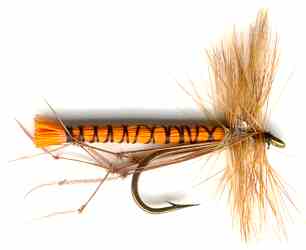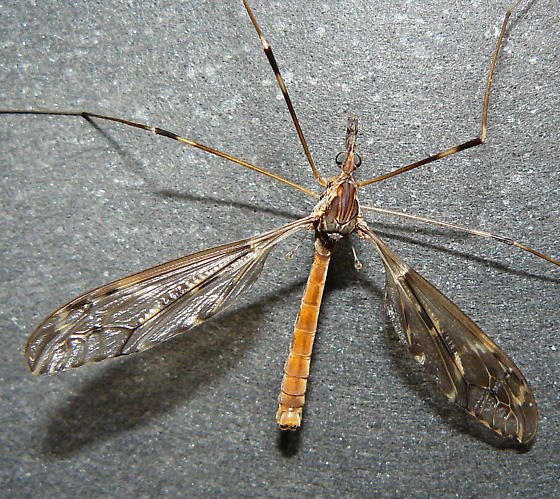Orange Daddy Long Legs Crane Fly
Over 300 different species of crane fly populate all kinds of water and are eaten by trout when they land or are blown onto water. They are more commonly known as Daddy Long Legs, but are classified as part of the Tipulidae biological family

Daddy Longlegs Dry Flies Hook size 10 - $US each
The biggest Daddy Longlegs Crane Fly (Tipulidae Maxia) has a wing span of around 65mm and the smallest has only a modest 15mm wing span. "Daddies" are a familiar sight at the water side from June onwards. They are often blown onto the water surface where they struggle in their attempts to become air-borne once more. Such large insects presents a good mouthful to the trout, which respond quickly. These flies are particularly important to the reservoir, lake or loch angler, because a large expanse of water is often too great a distance for these insects to fly across. Cast the daddy long leg fly to an area where trout activity is obvious on the surface. (They fly will need to be dunked well in floatant), then just wait for a fish to find it. When a take does occur resist the temptation to strike, as the trout will often try to drown the fly first, before taking it in it's mouth. Wait until the line starts to run out, then lift the rod high to set the hook. Drag a daddy long legs through a heavy ripple, or waves and the trout will often respond with a positive take. Daddies fished dry or dapped on the water will take trout, but you can use them for sea trout and salmon. Daddies are a windy day river fishing pattern. They are blown into the water, drowned and found by trout.
This is an ancient fly. The famous historic Fly Fisher Cotton mentions this fly in his book 'The Compleat Angler' but uses the Olde English name for the crane fly 'Harry Long-Legs'. In one of the first books written on the subject of fly fishing in English 'The Treatysse of Fysshynge With an Angle' published in 1496 written by the Abbess of Shropshire, Dame Juliana Berners the tenth fly recommended for use is believed to be the Crane fly. In those days the knightly gentleman fly fisher would catch the natural insect and attach it to his hook. The sporting fly fisherman of today prefers to use an artificial imitation of the crane fly Daddy Longlegs

The natural orange bodied Daddy Long Legs Crane Fly
The dry fly is designed to float on the surface of the water. To prevent it sinking, water repellent hackles are wound around the hook to distribute the weight over the surface of the water. The hackles also simulate the legs and splash of an aquatic or terrestrial insect trapped on the water surface. Most Dry flies are deceivers designed to imitate a specific natural fly like the crane fly, ant and hopper series of flies. Other flies like the Adams and Wickham's fancy are more general designs that are just intended to produce an edible looking fly.
Dry fly fishing has always been regarded as the supreme art in fly fishing circles. Accurate presentation of the fly can be essential. Trout will rise to a variety of natural flies but as far as the dry fly fisherman is concerned the mayfly hatch has to be the favored time. In almost all instances where trout feed on drowning land-borne insects the rule is not to move the fly. An imitation is far more likely to succeed if it is cast out and then left. So long as it is cast in the right spot.
The color of the fly is always important when matching the hatch, then size is the next important decision. The artificial fly does not have to be a precise imitation of the natural insect, but what is important is how and where it is presented in relation to the depth of water. This includes the height at which the fly floats above the surface of the water. Some fish will greedily take flies that are floating in the surface but ignore flies that are floating above it and visa versa depending on the conditions that day. Use your eyes to see which natural insects the fish are taking. A high-floating dry fly will have more chance of being taken on a bright day because of its visibility, but if it does not dent the surface film on a dull day it will be less effective. A fly floating in the surface on a sunless day leaves a much more visible halo of outlining light which surrounds it.
Trout rise to the surface during rain storms. The extra disturbance on the water oxygenates the upper layers and cools the water temperature to a more pleasant fish friendly environment. They feel safer as choppy water makes them invisible to birds of prey.. The falling rain beats down flying insects and forces them onto and under the water surface. Heavy rain also washes terrestrial insects into the water from the land, overhanging trees and shrubs. Summer storms are primetime for subsurface fishing. When the all the fair-weather fishermen are hiding under trees, in fishing huts or in their cars to keep dry, you will reap the rewards of some exciting fishing if you stay out in the rain.
Just cast out your fly and let the rain drown it, just like what is happening to the real insects. Do not add any floatant. It is best to cast frequently as you will cover more water and I have found that the fly is normally taken just after it has broken the water surface. Fishing in heavy rain is an ideal time to try out new patterns . Trout have learned to expect a variety of different foods, not normally available to them, washed into the lake or river from various sources. They have learned to expect this yummy bounty when the skies darken and the heavy rain drops pound the water surface. Drowned Daddy Longlegs, Hoppers, Ants, Wet flies and soft hackle north country Spiders are my choice on rainy days.
Daddy Longlegs fishing tactics
I love it when I spot daddy longlegs flying over or near the water. It does not matter if it is a river of stillwater, it means that there is the prospect of good sport ahead. If I am on a river I will usually fish with a solitary daddy longlegs pattern purely for ease of casting. This presented to a fish upstream will get good, solid, confident takes from any trout as long as they are not spooked.
Presentation is the key, try to make it as delicate as possible. Takes are always sure and solid. For river work I normally favour a natural colour daddy longlegs fly pattern. Always use a tapered leader and step up the breaking strain of the point to about 6lb to ensure good presentation. This will also ensure that you can land the odd sea trout that may appear, as I have found they seem to snap at these big flying insects when the fancy takes them. I will step up from my favoured 5-wt to a 6-wt rod if I know I am going to be fishing with a larger fly. It passes more energy down the line to the leader, helping it do its job.
When fishing on stillwaters, large or small, I have found bright coloured Daddies work the best even if there are no naturals on the water. If the naturals are about I use a floating if I am not dapping. Teams of three are very effective.
I cast them out and leave the flies to drift for a few seconds. If takes are not forthcoming, I lift the line and flies off the water. I then recast them at another angle. By covering the water this way I have found I can cast far more fish than by casting and retrieving.
I think this is because the trout are looking for daddy longlegs landing on the surface and then taking off. Daddy longlegs that start swimming in a line, as when they are retrieved, is unnatural behaviour. This puts some of the trout of taking these flies.
Customer's Comment
Stillwater is hard to read, but there is a little breeze and ripple, I look for a promontory where the breeze is going left to right or vice versa. Early in the season I measure the depth of the water (with an indicator - the only time I use them, as I'm a bit of a purist!) then from the promontory put a team of buzzers out to one side and let the breeze carry the line across the surface, so the flies search a large area of water. A good double haul cast helps here.
Later in the season a dry fly with nymph attached below can be very effective fished like this. The takes on the dry fly can be explosive. Then when it's time to fish a 'daddy' dry I put out a couple and let them drift over a large area. Again, I have found the takes on the 'daddy' can be ferocious! Otherwise, get yourself an inflatable and - here comes the plus (!) - buy a www.mcgregorfly.com boat rod and drift loch-style with a team of wets (or dries)! One of my favorite kinds of fly fishing on the classic Scottish lochs! Tight lines to all, Gregor Fulton McGregor


Fly Fishing books

